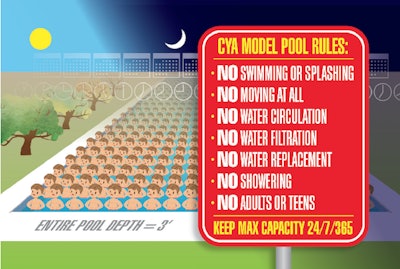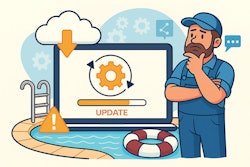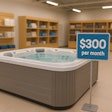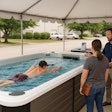
Editor's note: Within the industry this year, there has been a brisk debate about how much cyanuric acid to use in a swimming pool. In June, the CMAHC Cyanurate Ad Hoc Committee published a report on predicted infection rates using a mathematical model developed to simulate a swimming pool environment. In an article in September AQUA, "CYA and Chlorine in Plain Language," Ellen Meyer explained the Committee's case for lowered levels of CYA. Here, two distinguished experts in pool chemistry weigh in on this important scientific argument of central importance to the industry.
LIVE CYA DISCUSSIONIn an effort to help clarify the important issue of proper CYA usage in swimming pools, AQUA is organizing a forum on the topic at the PSP Expo in New Orleans this fall. “The Great CYA Debate” will be held Wednesday, Nov. 6, from 3-4 p.m. on the show floor. Look for details in the November issue of AQUA or in the show program. |
The Great CYA debate is one that has raged within the pool and spa industry for decades. Until recently, the discussion centered on laboratory studies and water quality data from real pools to help guide the technical standard for proper pool management. However, a new mathematical model has been created and has begun to enter into this debate.
It is important to remember that models are only as good as their assumptions. Models are created to help better understand complex systems, and anyone who has managed a swimming pool for any length of time knows how complex they can be. Models can become quite intricate in structure. But don't confuse a complicated model with a good one. A good model is one that uses sound assumptions to make predictions that can be tested and proven through scientific studies or real world data. Most importantly, predictions need to be tested before being accepted as fact.
The new model recently published by the CMAHC Cyanurate Ad Hoc Committee uses a very complex approach, including a multitude of spreadsheets to attempt to predict outcomes in pool water. It is because of this complexity and these many spreadsheets that this article is being written. After careful evaluation of the assumptions in this new model, we, as scientists, have come to the conclusion that the assumptions in this model are flawed and the resulting predicted outcomes do not align with years of collected data in real-world, pool water data.
FLAWED ASSUMPTIONS
A great deal of attention has been recently drawn to an idea that pool operators would realize better outcomes if they managed CYA stabilizer and free chlorine in relationship to each other via an artificial ratio devised through this new model. Several years ago someone suggested it be 7.5:1 CYA to FC. Now, the CMAHC Cyanurate Ad Hoc Committee suggests that it should actually be 20:1.
In reviewing the published study that focuses on this CYA stabilizer to free chlorine relationship, there are at least seven assumptions outlined in the model that do not reflect real-world pool situations. And unfortunately, these flawed assumptions are used in an attempt to simplify a complex real system, like pools, into a mathematically solvable format — a spreadsheet. Those flawed assumptions then generate flawed recommendations. In short, and borrowing a common phrase from the computer science world — "garbage in, garbage out." Prior to the creation of this new model, the CYA recommendations to be used by pool operators were based on data collected from actual swimming pools.
To emphasize the point, it is important for pool operators to review the puzzling assumptions that provide the foundation of support to the recent 20:1 CYA to FC Model. The assumptions in question are listed below and the statements in quotations come directly from the publication and its supplementary material:
1. Swimmer Movement: "Velocity of 0 cm/min in the x direction (Ux) was chosen to keep the model as simple as possible." This means that to rationalize the model, the authors assumed the swimmers in the pool are not swimming and are standing completely still for the entire time they are in the pool.
2. Pool Depth: "Depth of pool at 91.44 cm is a typical shallow pool depth of 3 feet" and "Distance between bathers 118.05 cm (3.87 ft.) is equivalent to 15 ft2/bather of surface area." So now all the swimmers are standing in three feet of water, in a grid 4 feet apart. And again, not moving…
3. Swimmers: What about these swimmers? The model assumes they are all children (based on the estimate of how much pool water they drink to get the model's exposure). Each model child spends around 2 hours a day, 73 days per year in the pool. As a reminder, this time spent in the pool requires them to arrange themselves in a 4-by-4-foot grid and stand around in 3 feet of water while not moving for those 2 hours a day, 73 days per year. Does this sound like the behavior of a typical swimmer, especially that of a child?
4. Pool Closure: "The model conservatively assumes continual sloughing 24 h/day, 7 days/ week at a constant bather load, thus not accounting for partial diurnal recovery from overnight disinfection." So the pool never closes and is always at the maximum capacity? Keep in mind that while each child only spends 2 hours in the pool, when that time is up they are instantly replaced by another child in the same spot. This continues in the pool for every child in every spot in the 4-by-4-foot grid for 24 hours a day, seven days per week.
5. Circulation: "For giardia and cryptosporidium, the maximum probability of infection occurs at very low diffusivity values (<100 cm2/min)" and "turbulent diffusion is typically in the hundreds to thousands of cm2/min." In other words, the risk is highest when the water isn't moving much — so the model assumes that the swimmers aren't moving and the pump is not running. The ratio described in the model does not factor in circulation and filtration, which is critical to maintaining a clean and sanitary pool and in and of itself would be cause for immediate closure of a commercial swimming pool facility.
6. Swimmer Waste: The model predicts how much feces each swimmer is putting into the pool (or in the case of this model, each standing person). However, the math behind the model is extremely sensitive to this assumption — if even 18 mg less poop (that is 35/10,000 ths of a teaspoon) is contributed by each standing person per hour they are in the pool, then a ratio of CYA to FC of 450:1 would be recommended by the model. Remember: This spreadsheet concludes that we should change decades of pool operating practices based on a guess as to how much swimmer waste there is. There is a pretty enormous difference in conclusions based on an extremely tiny amount of poop.
7. Water Replacement: To make the math work, the water is never replaced — no splash-out, no replacement water from backwash, no rain, no evaporation, no nothing. This is starting to sound less like a pool and more like a spreadsheet.
FLAWED RECOMMENDATIONS FROM FLAWED ASSUMPTIONS
The authors of the paper understand the modeling of giardia does not reflect the real world (emphasis in bold): "It was not possible to develop a model that provides accurate estimates of absolute risk." They go on to point out that "the high rate of giardia infection is not realistic but results from the assumptions used in this model: concentration of giardia in feces, percent of population infected with giardia, every visit to a pool with no chlorine and constant 24 hour/ day 7 day/week high bather load, and no filtration of cysts." How can the authors confidently believe in the increased relative risk of giardia infection if they admit that rate of infection is not realistic?
The answer is they can't, which is what actual data from real pools tells us. There are dozens of recreational water illness outbreak reports in numerous scientific journals. The CDC
has been periodically publishing RWI summaries since 1978 with the latest one covering 2000 to 2014 (CDC 2018). These are pools operating under the current guidance on cyanuric acid, so certainly a vast majority of those using CYA are operating far above a 20:1 ratio, and in that period of time there are zero reported cases of E. coli, shigella, pseudomonas, legionella, norovirus and, very importantly for this discussion, giardia, when there was proven to be 1 ppm of free chlorine in the water. This is the real-world data published by CDC, not the output from a spreadsheet.
To give this some perspective, the CDC estimates that pools in the US have 301 million swimmer visits per year. Given that number of visits, then the model would predict the following, compared to what we actually see: Click to enlarge
Click to enlarge
Using the assumptions within the model that determine the proposed 20:1 ratio, and assuming that there was zero chlorine during an outbreak, the incidence of giardia is overestimated by more than 15,000,000 cases per year. The model similarly overestimates the incidence of E. coli by over 100,000 cases. If we look at the model's prediction for pools that were run at the highest ratio of CYA and FC that fits with the current recommendations of 1 ppm FC and 100 ppm of CYA, there should be more than 750,000 cases of giardia coming from those pools each year. How many have actually been observed from pools that were confirmed to have 1 ppm of FC? Zero. How confident can we be in changing decades of practices — practices that are demonstrated to effectively prevent illnesses due to pathogens susceptible to chlorine — based on a model that so severely overestimates the scope of the problem?
CONCLUSION
The key takeaway from this — where both model and real-world experiences agree — is that the most important factor in keeping a clean, healthy swimming environment is proper pool maintenance and keeping a chlorine residual of 1-4 ppm. Cyanuric acid helps prevent sunlight from destroying that residual, which makes it easier and less expensive for pool operators to maintain the appropriate chlorine level. We need to ask ourselves, who is behind the continuous push to further regulate cyanuric acid in the industry? If we are truly concerned about public health, our focus needs to be on maintaining recommended levels of free chlorine to prevent disease from the readily controlled pathogens and on using secondary disinfection systems and proper maintenance practices to combat crypto outbreaks. Rather than swimming in spreadsheets, let's be sure bathers are swimming in clean and clear pool water.
ReferencesCDC. 2018. Outbreaks Associated with Treated Recreational Water — United States, 2000–2014. MMWR, 67, 547-551. Falk, R.A., et al. 2019. Assessing the Impact of Cyanuric Acid on Bather's Risk of Gastrointestinal Illness at Swimming Pools. Water, 11, 1314-1347. |
Dr. Roy Vore is technology manager at BioLab and a recognized expert in recreational water chemistry. He is a CPO, an active contributor to PHTA's Recreational Water Quality Committee, a major contributor to the Disinfection Water Quality module of the Model Aquatic Health Code (the "MAHC") and the lead author of NSPF's Recreational Water Illness handbook. Dr. Vore holds a Ph.D. in bacterial physiology, masters and bachelors in microbiology. He has published over 80 scholarly papers and presentations on the selection and use of industrial biocides, biocide testing methodology, the microbiological of swimming pools and spas and the governmental regulation of biocides.
Dr. Jeffrey Gaulding began his career in the pharmaceutical industry and has been working in the pool and spa industry for several years. Dr. Gaulding is a CPO and recently joined the PHTA's Recreational Water Quality Committee. He received his PhD in chemistry from Georgia Tech and his BS from Emory University.











































